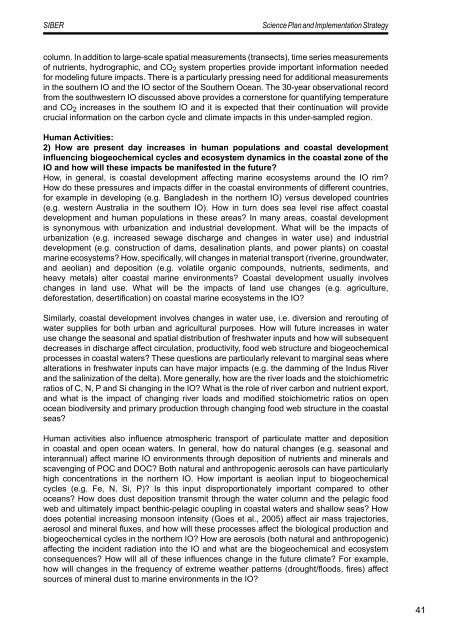SIBER SPIS sept 2011.pdf - IMBER
SIBER SPIS sept 2011.pdf - IMBER
SIBER SPIS sept 2011.pdf - IMBER
Create successful ePaper yourself
Turn your PDF publications into a flip-book with our unique Google optimized e-Paper software.
<strong>SIBER</strong><br />
Science Plan and Implementation Strategy<br />
column. In addition to large-scale spatial measurements (transects), time series measurements<br />
of nutrients, hydrographic, and CO 2 system properties provide important information needed<br />
for modeling future impacts. There is a particularly pressing need for additional measurements<br />
in the southern IO and the IO sector of the Southern Ocean. The 30-year observational record<br />
from the southwestern IO discussed above provides a cornerstone for quantifying temperature<br />
and CO 2 increases in the southern IO and it is expected that their continuation will provide<br />
crucial information on the carbon cycle and climate impacts in this under-sampled region.<br />
Human Activities:<br />
2) How are present day increases in human populations and coastal development<br />
influencing biogeochemical cycles and ecosystem dynamics in the coastal zone of the<br />
IO and how will these impacts be manifested in the future<br />
How, in general, is coastal development affecting marine ecosystems around the IO rim<br />
How do these pressures and impacts differ in the coastal environments of different countries,<br />
for example in developing (e.g. Bangladesh in the northern IO) versus developed countries<br />
(e.g. western Australia in the southern IO). How in turn does sea level rise affect coastal<br />
development and human populations in these areas In many areas, coastal development<br />
is synonymous with urbanization and industrial development. What will be the impacts of<br />
urbanization (e.g. increased sewage discharge and changes in water use) and industrial<br />
development (e.g. construction of dams, desalination plants, and power plants) on coastal<br />
marine ecosystems How, specifically, will changes in material transport (riverine, groundwater,<br />
and aeolian) and deposition (e.g. volatile organic compounds, nutrients, sediments, and<br />
heavy metals) alter coastal marine environments Coastal development usually involves<br />
changes in land use. What will be the impacts of land use changes (e.g. agriculture,<br />
deforestation, desertification) on coastal marine ecosystems in the IO<br />
Similarly, coastal development involves changes in water use, i.e. diversion and rerouting of<br />
water supplies for both urban and agricultural purposes. How will future increases in water<br />
use change the seasonal and spatial distribution of freshwater inputs and how will subsequent<br />
decreases in discharge affect circulation, productivity, food web structure and biogeochemical<br />
processes in coastal waters These questions are particularly relevant to marginal seas where<br />
alterations in freshwater inputs can have major impacts (e.g. the damming of the Indus River<br />
and the salinization of the delta). More generally, how are the river loads and the stoichiometric<br />
ratios of C, N, P and Si changing in the IO What is the role of river carbon and nutrient export,<br />
and what is the impact of changing river loads and modified stoichiometric ratios on open<br />
ocean biodiversity and primary production through changing food web structure in the coastal<br />
seas<br />
Human activities also influence atmospheric transport of particulate matter and deposition<br />
in coastal and open ocean waters. In general, how do natural changes (e.g. seasonal and<br />
interannual) affect marine IO environments through deposition of nutrients and minerals and<br />
scavenging of POC and DOC Both natural and anthropogenic aerosols can have particularly<br />
high concentrations in the northern IO. How important is aeolian input to biogeochemical<br />
cycles (e.g. Fe, N, Si, P) Is this input disproportionately important compared to other<br />
oceans How does dust deposition transmit through the water column and the pelagic food<br />
web and ultimately impact benthic-pelagic coupling in coastal waters and shallow seas How<br />
does potential increasing monsoon intensity (Goes et al., 2005) affect air mass trajectories,<br />
aerosol and mineral fluxes, and how will these processes affect the biological production and<br />
biogeochemical cycles in the northern IO How are aerosols (both natural and anthropogenic)<br />
affecting the incident radiation into the IO and what are the biogeochemical and ecosystem<br />
consequences How will all of these influences change in the future climate For example,<br />
how will changes in the frequency of extreme weather patterns (drought/floods, fires) affect<br />
sources of mineral dust to marine environments in the IO<br />
41












